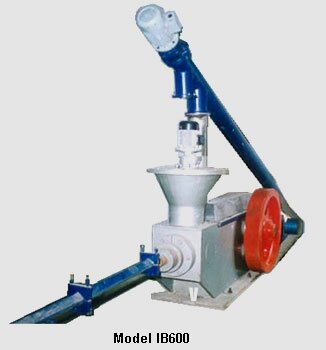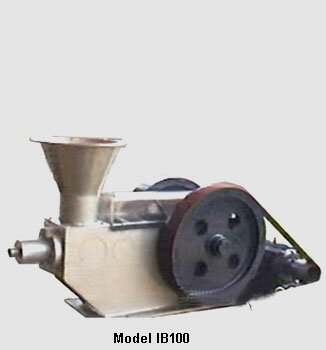|
|
|
|
Briquetting Press
CONCEPT – PROCESS
The process of "BRIQUETTING" is the physical transformation of the loose raw material into a compact form. The form change results in a much higher specific density of the material, which increases its combustion efficiency as compared to the loose material.
The following agricultural and forest wastes and residues can easily be converted into fuel briquettes.
| Forest Wastes and Residues |
Agricultural Wastes and Residues |
| a. Saw Dust, Sandar Dust |
a. Husks - Rice, Coffee, Sunflower |
| b. Wood Chips and Shavings |
b. Shells - Groundnut, Almond, others |
| c. Tree Bark and Twigs |
c. Cotton Stalks,Arhar Stalks |
| d. Pine Needles |
d. Bagasse, Sugarcane Leaves and Trash |
| e. Wild Grasses and Shrubs |
e. Maize Stalks and Cobs |
| f. Bamboo Leaves etc. |
f. Mustard Stalks |
| |
g. Bajra Cobs |
|
|
h. Coir Dust, etc.
|
* Calorific value of these agrowastes range from 3500 kcal/kg to 4500 kcal/kg.
* These and other materials can be briquetted individually or in combination
2. TYPICAL PROPERTIES OF BIOMASS BRIQUETTES
- Biomass briquettes have calorific values ranging from 3400 to 4200 kcal/kg *.
- The ash content is only 2 to 20%. *
- It is equivalent to `B' Grade coal in terms of calorific value.
- They do not emit any harmful substances like SO2 or nitrogen oxide during combustion.
- The bulk density is in the range of 800 - 900 kg/m3
* depends on raw material
3. BENEFITS OF THE PROCESS
The main advantages of briquetting are :
- The bulk density of biomass is increased multifold, thus saving in storage, transportation & handling costs.
- Uniform physical dimensions & combustion characteristics, results in more efficient energy conversion.
- Facility for efficient utilization of a renewable source & as an alternative to fossil fuels like coal, lignite, etc.
- Dust pollution associated with direct combustion of loose biomass can be avoided.
- Biomass briquettes can be used in almost any type of existing combustion grates..
4. MANUFACTURING PROCESS OF BRIQUETTING
- Waste materials are tested for their chemical composition to decide on their suitability and to select a proper mix.
- Sun dried material containing approximately. 10 - 15 % moisture is suitable for briquetting. However if material has higher moisture content it needs to be dried before use.
- Material is screened, chopped and ground to get the desired size and bulk density and is pneumatically transported into storage bins. This helps in separation of the heavier and metallic particles and also unifying moisture content in the material. Air used is hot or wet as the case may be, for control of moisture. ln this process the cellulose bonding in biomass collapses due to application of high pressure (1200 kg/sq.cm), and temperature (200 o C) & more thereby fluidizing the lignin.
- The moisture content in the material should be lesser than 12% for best results during compaction. Material from bin is discharged to the machine through regulated conveyors where it is compressed in specially designed dies. The compression raises the temperature of the material, softening some of the inherent binders in it, which come to the surface and bind the material together.
- Briquettes formed are in the shape of logs or pellets, which are forced through tracks for proper shaping, by cooling them under pressure.
- Cooled briquettes are packed in bags or stored in bulk for shipment or use.
- No Binder is required in the process.
5. USES AND APPLICATION
Briquetted fuel can be used by the industrial, commercial and household sectors. It is ideally suited for use in the following areas::
| a. |
Boilers |
(sugar mills, paper mills, chemical plants, dyeing houses, food processing units, oil extraction units, vanaspati units etc.) using fuel for steam generation and heating. |
| b. |
Forges and Foundries |
For metal heating and melting. |
| c. |
Brick kilns and Ceramic Units For firing of furnaces. |
| d. |
Residential Heating |
For winter heating in cold areas and in restaurants, canteens etc. |
| e. |
Biomass Gasifier |
The gas can be used in Biomass Gasifiers to generate power, /replace oil in furnaces, ovens etc. |
6. PRODUCT SPECIFICATION
Fuel briquette is black / brown in colour.. When agro-waste of cellular nature is briquetted, it produces low cost, high calorific value fuel which can from a good substitute for wood and coal. This implies conversion of waste into a useful energy source. The end product has the following typical proximate analysis :-
| i. |
Ash |
2 to 10 % |
| ii. |
Moisture |
7 % |
| iii |
Volatile |
30 - 60 % |
| iv |
Fixed carbon |
30 - 60 % |
| v. |
Gross calorific Value |
3500 to 4500 kcal/kg. |
| vi. |
Size of briquettes |
Diameter 60 - 62 mm |
| vii. |
Length of Briquettes |
Length 50 to 200 mm |
Infinite manufactures two types of Briquetting System, These are
- Impact Type (Die & Punch)
The Infinite Impact Briquettor is an extremely rugged positive displacement type biomass Briquetting machine that can transform any biomass in dry, granular form into solid fuel briquettes of up to 1400 kg/m3 density without the use of external binders.
Any biomass or a mixture of biomass is transformed into a high density solid briquette in a single operation in the Infinite Impact Briquettor.
The Infinite Impact Briquettor generates extremely high pressures of up to 22500 psi, which forces the loose biomass through a die. The high pressure and the friction within the die causes the biomass to heat up and release the lignin (which acts as binder) from the biomass cell structure and bond into briquettes. The hot briquettes thus formed are extruded through a split die from the front of the machine and are cooled under pressure in the "cooling length" to retain their strength and density.

|

|
| Please click on Picture to Download Brochure |
Please click on Picture to Download Brochure |
|
|
The screw briquettor is a screw extruder with specially designed die and screw that can compact and bind dry biomass into a high density briquette in a single operation.
The screw briquettor consists of an intake hopper that delivers the biomass into the feed chamber. The extrusion screw force feeds the biomass in the feed chamber into the preheated die where the briquette is formed.
| Model |
INFINITE-SCR-75 |
| Rated Capacity |
100-150 kg/h |
| Main Drive Motor |
15 hp, 3 ph, 4 pole, Foot Mounted |
| Heaters |
3 nos, 1.5 kW, 1 Phase |
| Briquette Diameter |
75 mm |
| Floor area |
1000 mm x1200 mm |
| Weight |
400 kgs |
| Foundation |
Not Required |
|
|
|
|
|
|
|